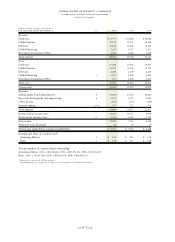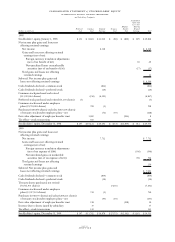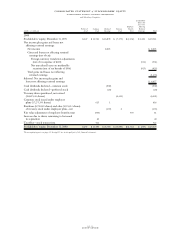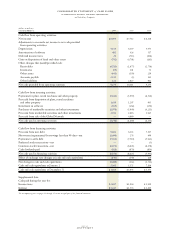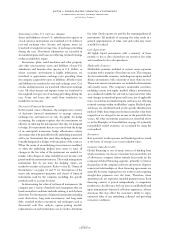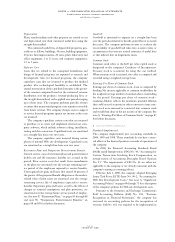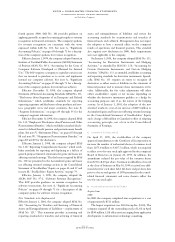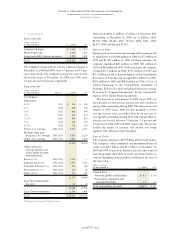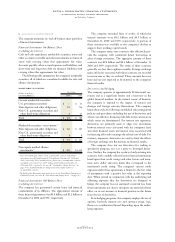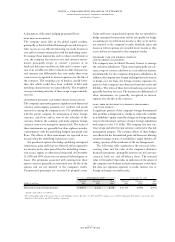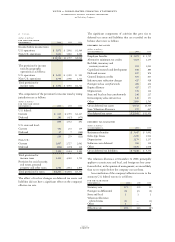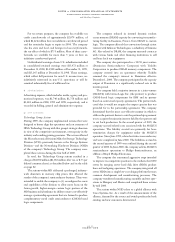IBM 2000 Annual Report Download - page 73
Download and view the complete annual report
Please find page 73 of the 2000 IBM annual report below. You can navigate through the pages in the report by either clicking on the pages listed below, or by using the keyword search tool below to find specific information within the annual report.
notes to consolidated financial statements
international business machines corporation
and Subsidiary Companies
page no.
seventy-one
Depreciation
Plant, rental machines and other property are carried at cost
and depreciated over their estimated useful lives using the
straight-line method.
The estimated useful lives of depreciable properties gen-
erally are as follows: buildings, 50 years; building equipment,
20 years; land improvements, 20 years; plant, laboratory and
office equipment, 2 to 15 years; and computer equipment,
1.5 to 5 years.
Software Costs
Costs that are related to the conceptual formulation and
design of licensed programs are expensed as research and
development. Also, for licensed programs, the company
capitalizes costs that are incurred to produce the finished
product after technological feasibility is established. The
annual amortization of the capitalized amounts is the greater
of the amount computed based on the estimated revenue
distribution over the products’ revenue-producing lives, or
the straight-line method, and is applied over periods ranging
up to three years. The company performs periodic reviews
to ensure that unamortized program costs remain recoverable
from future revenue. The company charges costs to support
or service licensed programs against net income as the costs
are incurred.
The company capitalizes certain costs that are incurred
to purchase or to create and implement internal use com-
puter software, which include software coding, installation,
testing and data conversion. Capitalized costs are amortized
on a straight-line basis over two years.
The company capitalizes costs incurred during certain
phases of internal Web site development. Capitalized costs
are amortized on a straight-line basis over two years.
Retirement Plans and Nonpension Postretirement Benefits
Current service costs of retirement plans and postretirement
health care and life insurance benefits are accrued in the
period. Prior service costs that result from amendments
to the plans are amortized over the average remaining serv-
ice period of the employees expected to receive benefits.
Unrecognized net gains and losses that exceed 10 percent of
the greater of the projected benefit obligation or the market-
related value of plan assets are amortized over the average
remaining service life of employees expected to receive
benefits. Experience gains and losses, as well as the effects of
changes in actuarial assumptions and plan provisions, are
amortized over the average future service period of employ-
ees. See note V, “Retirement Plans,” on pages 85 through 88
and note W, “Nonpension Postretirement Benefits,” on
pages 88 and 89 for further discussion.
Goodwill
Goodwill is amortized to expense on a straight-line basis
over the periods estimated to benefit, generally not to exceed
five years. The company performs reviews to evaluate the
recoverability of goodwill and takes into account events or
circumstances that warrant revised estimates of useful lives
or that indicate that an impairment exists.
Common Stock
Common stock refers to the $.20 par value capital stock as
designated in the company’s Certificate of Incorporation.
Treasury stock is accounted for using the cost method.
When treasury stock is reissued, the value is computed and
recorded using a weighted-average basis.
Earnings Per Share of Common Stock
Earnings per share of common stock
—
basic is computed by
dividing Net income applicable to common stockholders by
the weighted-average number of common shares outstanding
for the period. Earnings per share of common stock
—
assuming dilution reflects the maximum potential dilution
that could occur if securities or other contracts to issue com-
mon stock were exercised or converted into common stock
and would then share in the net income of the company. See
note S, “Earnings Per Share of Common Stock,” on page 83
for further discussion.
BACCOUNTING CHANGES
Standards Implemented
The company implemented new accounting standards in
2000, 1999 and 1998. These standards do not have a mate-
rial effect on the financial position or results of operations of
the company.
In 2000, the Financial Accounting Standards Board
(FASB) issued Interpretation (FIN) No. 44, “Accounting for
Certain Transactions Involving Stock Compensation, an
interpretation of Accounting Principles Board Opinion
No. 25.” The requirements of FIN No. 44 are either not
applicable to the company or are already consistent with the
company’s existing accounting policies.
Effective July 1, 2000, the company adopted Emerging
Issues Task Force (EITF) Issue No. 00-2, “Accounting for
Web Site Development Costs.” See note A, “Significant
Accounting Policies” on pages 69 through 71 for a description
of the company’s policies for Web site development costs.
Pursuant to the Securities and Exchange Commission’s
Staff Accounting Bulletin (SAB) No. 101, “Revenue
Recognition in Financial Statements,” the company has
reviewed its accounting policies for the recognition of
revenue. SAB No. 101 was required to be implemented in





